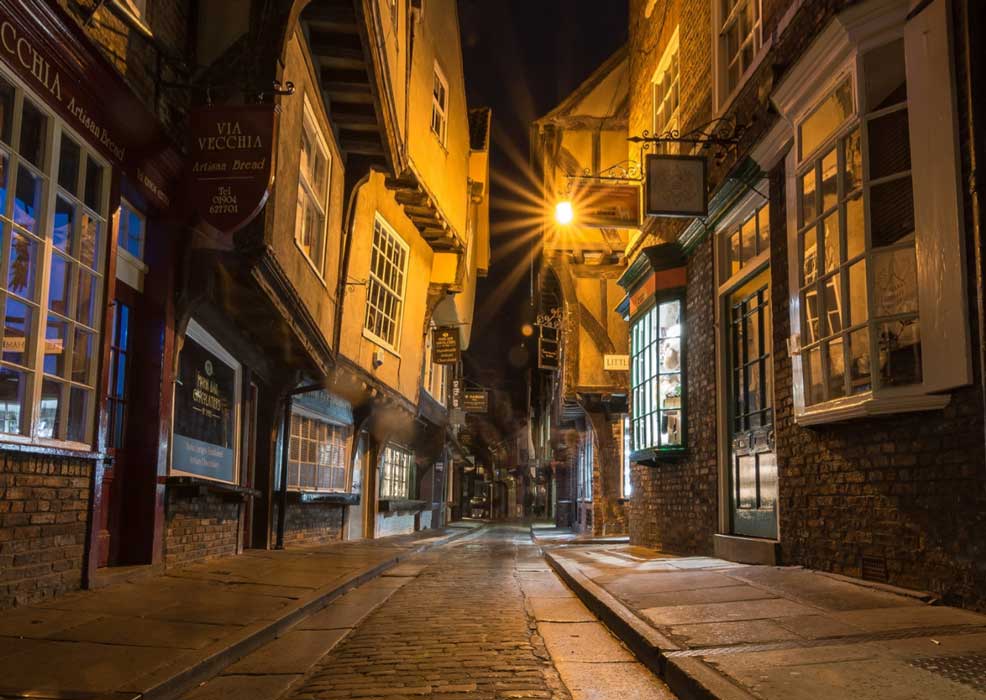The Shambles: Medieval Slaughterhouse Street Turned Tourist Hotspot
The Shambles (known officially as Shambles) is a street in York dating to the Middle Ages. Shambles has been called the best-preserved Medieval street in Europe and has been voted as the most picturesque street in Britain. It’s no surprise Shambles is a popular tourist attraction and it attracts millions of visitors each year.
A Middle Age Butchers’ Market
According to one theory, the name ‘Shambles’ is derived from the Old English word ‘sceamel’, which means ‘stool’ or ‘bench’. This was apparently meant to be a reference to the table or stall on which meat or fish was displayed for sale. Another theory suggests that the name of the street comes from the Saxon ‘Fleshammels’, which may be translated to mean ‘flesh shelves’, which refers to the shelves on which butchers used to display their meats. Thus, Shambles was the place where the city’s butcher’s market was located.
![Shambles from "Picturesque York. [With illustrations.]" (1886) (Public Domain)](https://www.ancient-origins.net/sites/default/files/Picturesque-York.jpg)
Shambles from "Picturesque York. [With illustrations.]" (1886) (Public Domain)
Shambles is mentioned in the Domesday Book, which was completed in the year 1086. It is likely, however, that this street was already in existence prior to the Norman Conquest of England in 1066. Up until 1872, there were as many as 25 butchers’ shops in Shambles. Today, however, none of these businesses exist. Nevertheless, the wide window sills of the buildings, on which the meat was displayed, still remain. But York was not the only city with Shambles, as other British cities, including Worcester, Whitby, and Chesterfield, also have a street with the same name.
- Legendary Landmark and Talisman ‘The London Stone’ to be Returned to Cannon Street
- 90,000 panoramic photos bring to life ancient sites of Cambodia on Google Street View
- Medieval Villagers Were Ready to Mutilate Potential Zombies

Intersection of Shambles and Little Shambles streets, York. (Peter K Burian/CC BY SA 4.0) You can see the wide window sills on some buildings, on which the meat was displayed, still remain.
Shopping on Shambles
Today, the butcher’s shops have been replaced by businesses catering to the taste of tourists visiting the street. These include souvenir shops, restaurants, and shops selling antiquities. The Shambles is considered one of the foremost shopping areas in York. Although the businesses have changed, the buildings themselves have been preserved. For example, the overhanging timber-framed fronts of the buildings, which are deliberately close-set, have been left in place. Some parts of Shambles are so narrow that it is possible for one to touch both sides of the street with arms outstretched.

The Shambles, York, at night. (Sebastian Mrozek/CC BY SA 3.0)
This deliberate design served a practical purpose. The protruding timber-framed fronts were meant to protect the walls below, which were made of wattle and daub, from the elements. Moreover, this design shielded the meat in the butcher’s shops from being directly exposed to the sunlight, which would cause it to go bad faster.
Another practical feature of Shambles is the pavements that were raised on either side of the street. During the Middle Ages, the butchers of Shambles would usually throw blood and offal down into the middle of the cobbled street. The raised pavements formed a channel and twice a week the butchers would wash away the waste products that they had thrown in it. Interestingly, one of the butcher’s shops even has a slopping floor so as to further facilitate that removal of animal remains into the street.
- A Labyrinth of Ancient Tunnels Exist Under Roman Streets
- Violent Water and Filth? People Fought Dirty in the Medieval Streets of Aberdeen, Scotland
- Amateur Treasure Hunter Will Make Thousands of Dollars from a Medieval Gold Ring

The Shambles in York. (CC0) Note the raised pavement which form a channel.
The Pearl of York
One of the best-known residents of Shambles was a saint by the name of Margaret Clitherow (sometimes known as the ‘Pearl of York’). She was a saint who lived during the 16th century who was married to a butcher by the name of John Clitherow. Needless to say, John’s business was on Shambles. In 1574, Margaret converted to Roman Catholicism. In England Roman Catholicism was being persecuted at this time and Margaret would ultimately pay for her faith with her life.
In 1586, Margaret was arrested on the charge of harboring Catholic priests. She refused to plea, as that would involve a trial in which her children would be forced to testify. She was tortured and then condemned to being crushed to death. Margaret was executed on Good Friday 1586, and was canonized as a saint in 1970 by Pope Paul VI. Shambles has a shrine to the saint.
Top image: A photo of Shambles, York, UK. Source: Chris Combe/CC BY 2.0
By Wu Mingren
References
Carter, H., 2010. It's a Shambles – but it's the most picturesque street in Britain. Available at: https://www.theguardian.com/travel/2010/mar/08/shambles-wins-google-street-view-awards
Ross, D., 2018. The Shambles. Available at: https://www.britainexpress.com/cities/york/shambles.htm
satxwdavis, 2018. Shambles of York. Available at: https://www.atlasobscura.com/places/shambles-of-york
www.yorkshireguides.com, 2006. The Shambles. Available at: http://www.yorkshireguides.com/shambles.html
www.york-united-kingdom.co.uk, 2018. The history of The Shambles York England - Margaret Clitherow.
Available at: http://www.york-united-kingdom.co.uk/shambles/
York Museums Trust, 2018. The Shambles. Available at: http://www.historyofyork.org.uk/themes/medieval/the-shambles
York:PM, 2018. The Shambles. Available at: http://www.york-pm.co.uk/the-shambles/

















